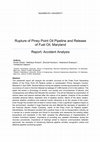Papers by Yerkebulan Saparov

The presented report will analyze the accident occurred at the Chalk Point Generating Station of ... more The presented report will analyze the accident occurred at the Chalk Point Generating Station of the Piney Point Oil Pipeline system in southeastern Prince George's Country, Maryland in April 2000. Several failures during the pipeline monitoring procedures resulted in occurrence of crack in the line followed by leakage of 3,089 barrels of oil to the wetland. The paper will review a chronology of events, root causes and circumstances of failures, and consequences and effects that followed the accident. This will be followed by examination of actions taken and lessons learned after the rupture of oil pipeline. Analysis of the accident revealed personal failure, expiration time of pipeline section, failure of the alarm system, adverse weather conditions and external human influences to be the causes of the crash. Even though the accident did not lead to human loses, it had a significant negative impact on the environment, resulted in huge financial loss and affected the decrease of...
The basis of comprehension of power-flow problems obtained from lectures, lecture slides and subj... more The basis of comprehension of power-flow problems obtained from lectures, lecture slides and subject book. Circuit built and simulated in the Power World program, and then the analytical solution obtained using the theoretical knowledge. Finally, both answers were compared with each other and the difference in the figures were deducted and discussed elaborately.

The presented report will analyze the accident occurred at the Chalk Point Generating Station of ... more The presented report will analyze the accident occurred at the Chalk Point Generating Station of the Piney Point Oil Pipeline system in southeastern Prince George's Country, Maryland in April 2000. Several failures during the pipeline monitoring procedures resulted in occurrence of crack in the line followed by leakage of 3,089 barrels of oil to the wetland. The paper will review a chronology of events, root causes and circumstances of failures, and consequences and effects that followed the accident. This will be followed by examination of actions taken and lessons learned after the rupture of oil pipeline. Analysis of the accident revealed personal failure, expiration time of pipeline section, failure of the alarm system, adverse weather conditions and external human influences to be the causes of the crash. Even though the accident did not lead to human loses, it had a significant negative impact on the environment, resulted in huge financial loss and affected the decrease of reputation of the Potomac Electric Power Company, owner of the Piney Point Oil Pipeline system. Nevertheless, the Maryland accident left a positive trace in the oil transportation industry as it served as a severe example and forced to reconsider and reexamine the existing safety precautions and standards in this field, revealed the effectiveness of implementation of Incident Command System, importance of providing any updated information during the recovery procedures, importance of trainings aimed to improve communication between personnel, the necessity of introducing National pipeline wrinkles recognition criteria and effective pipeline monitoring system.

Increase of energy consumption in the world and importance of CO2 reduction
stimulate developmen... more Increase of energy consumption in the world and importance of CO2 reduction
stimulate development of alternative sources of energy. Kazakhstan territory has high
potential for wind energy industry development. As a result, Republic of Kazakhstan
increases energy production from wind, solar and other renewable resources.
This purpose of the Project is Feasibility Report for construction of 50 MW wind farm
station near Ereymentau, Akomla region. Initially, current wind industry situation is
investigated in Chapter 1. After that, Ereymentau’ wind potential assessment is done in order
to calculate possible energy production. Then, turbine type is chosen and technical details of
wind park is analyzed. Afterward, detailed economy analysis of the project is given in
Chapter 6. Safety and Risk assessment are covered in Chapters 7 and 8. Next, environmental
impact is discussed in Chapter 9. Project Management is given in the last Chapter.
Summary of Final Feasibility of the wind park Project near Ereymentau and
recommendations are given in Chapter 11.

Today’s main challenges for most of the VLSI circuit designers are to decrease the area of the ci... more Today’s main challenges for most of the VLSI circuit designers are to decrease the area of the circuit and reduce power dissipation. The leading world companies are working on continuous improvement of the existing technologies. Quest for ideas in optimization of productive speed, reducing the propagation delays and power consumption along with compactness and minimization of production costs of triggers are the main objectives of producers of electronics and digital equipment. The question of improvement of logical gate design is particularly acute. Particularly, the power consumption is one of the key factors in any integrated circuit. Considering the complexity of modern integrated circuits, processors now consume large amount of power as they make maximum number of internal transitions. Therefore, the most actual question is to find the techniques to effectively implement low power systems in integrated circuits design.











Uploads
Papers by Yerkebulan Saparov
stimulate development of alternative sources of energy. Kazakhstan territory has high
potential for wind energy industry development. As a result, Republic of Kazakhstan
increases energy production from wind, solar and other renewable resources.
This purpose of the Project is Feasibility Report for construction of 50 MW wind farm
station near Ereymentau, Akomla region. Initially, current wind industry situation is
investigated in Chapter 1. After that, Ereymentau’ wind potential assessment is done in order
to calculate possible energy production. Then, turbine type is chosen and technical details of
wind park is analyzed. Afterward, detailed economy analysis of the project is given in
Chapter 6. Safety and Risk assessment are covered in Chapters 7 and 8. Next, environmental
impact is discussed in Chapter 9. Project Management is given in the last Chapter.
Summary of Final Feasibility of the wind park Project near Ereymentau and
recommendations are given in Chapter 11.
stimulate development of alternative sources of energy. Kazakhstan territory has high
potential for wind energy industry development. As a result, Republic of Kazakhstan
increases energy production from wind, solar and other renewable resources.
This purpose of the Project is Feasibility Report for construction of 50 MW wind farm
station near Ereymentau, Akomla region. Initially, current wind industry situation is
investigated in Chapter 1. After that, Ereymentau’ wind potential assessment is done in order
to calculate possible energy production. Then, turbine type is chosen and technical details of
wind park is analyzed. Afterward, detailed economy analysis of the project is given in
Chapter 6. Safety and Risk assessment are covered in Chapters 7 and 8. Next, environmental
impact is discussed in Chapter 9. Project Management is given in the last Chapter.
Summary of Final Feasibility of the wind park Project near Ereymentau and
recommendations are given in Chapter 11.